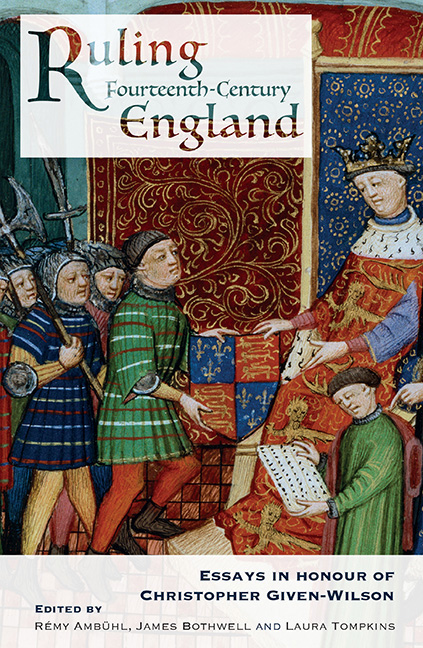Book contents
- Frontmatter
- Contents
- Contributors
- Abbreviations
- Introduction
- The Efficiency of English Royal Administration in the Last Years of Edward I
- Government and Market in the Early Fourteenth Century
- Kings' Clerks: The Essential Tools of Government
- Edward II: Favourites, Loyalty and Kingship
- The Perils of Lordship: The Life and Death of William Tuchet (c. 1275–1322)
- ‘War’, ‘Rebellion’ or ‘Perilous Times’? Political Taxonomy and the Conflict in England, 1321–2
- The Carlisle Roll of Arms and the Political Fabric of Military Service under Edward III
- What's in a Title? Comital Development, Political Pressures and Questions of Purpose in Fourteenth-Century England
- Edward the Black Prince: Lordship and Administration in the Plantagenet Empire
- ‘Said the Mistress to the Bishop’: Alice Perrers, William Wykeham and Court Networks in Fourteenth-Century England
- The Politics of Surrender: Treason, Trials and Recrimination in the 1370s
- Richard II in the Mirror of Christendom
- Bibliography
- Index
- Tabula Gratulatoria
The Carlisle Roll of Arms and the Political Fabric of Military Service under Edward III
Published online by Cambridge University Press: 18 September 2019
- Frontmatter
- Contents
- Contributors
- Abbreviations
- Introduction
- The Efficiency of English Royal Administration in the Last Years of Edward I
- Government and Market in the Early Fourteenth Century
- Kings' Clerks: The Essential Tools of Government
- Edward II: Favourites, Loyalty and Kingship
- The Perils of Lordship: The Life and Death of William Tuchet (c. 1275–1322)
- ‘War’, ‘Rebellion’ or ‘Perilous Times’? Political Taxonomy and the Conflict in England, 1321–2
- The Carlisle Roll of Arms and the Political Fabric of Military Service under Edward III
- What's in a Title? Comital Development, Political Pressures and Questions of Purpose in Fourteenth-Century England
- Edward the Black Prince: Lordship and Administration in the Plantagenet Empire
- ‘Said the Mistress to the Bishop’: Alice Perrers, William Wykeham and Court Networks in Fourteenth-Century England
- The Politics of Surrender: Treason, Trials and Recrimination in the 1370s
- Richard II in the Mirror of Christendom
- Bibliography
- Index
- Tabula Gratulatoria
Summary
The historiography of late medieval English military organisation is punctuated by instances of archival serendipity: by occasions when the discovery of a document, misidentified by cataloguers or simply overlooked, has transformed our understanding of an army or military event, often illuminating the wider context as well. For an archival researcher there is nothing quite like that flash of recognition when the significance of what lies on the desk before you sinks in. For me, the realisation that two membranes packed with the names of several hundred men-at-arms and archers, which had been included in a file of miscellaneous fragments, was actually the long-detached lower portion of Henry of Lancaster's retinue roll for his expedition to Aquitaine in 1345–6 was quite literally a hair-raising moment. It was no doubt the same for Charity Scott-Stokes when she realised that a manuscript in the Cranston Library at St Mary's Parish Church in Reigate contained both an earlier and a fuller version of the chronicle published by James Tait in 1914 under the title of Chronicon Anonymi Cantuariensis: a manuscript that, with Chris Given-Wilson's collaboration, has been brought to publication in the Oxford Medieval Texts series. Somewhat different are those discoveries involving documents that, while long known and correctly identified, yield their true significance only within a research context informed by the interdisciplinary cross-fertilisation of knowledge. This is very much the case with the Carlisle Roll of Arms. Although long recognised as an ‘occasional roll’ associated with Edward III's large-scale expedition into Scotland during the summer of 1335, and duly exploited for its heraldic content, it has rarely been used by those interested in military organisation and recruitment.
The Carlisle Roll, which has come down to us in a single copy dating from the mid-fifteenth century, consists of 276 names and blazoned arms (CA 1–276), accompanied by painted shields, arranged in book form. After the first folio, which has an introductory heading and the constable's arms, there are two columns of three shields on each page. The fifteenth-century copyist's work is littered with errors. Sir Anthony Wagner drew attention to the ‘comical misunderstandings and elementary mistakes’ that affect the painted arms, but more disruptive from the historian's point of view are the numerous instances of garbled names and mis-transcribed blazon.
- Type
- Chapter
- Information
- Ruling Fourteenth-Century EnglandEssays in Honour of Christopher Given-Wilson, pp. 133 - 162Publisher: Boydell & BrewerPrint publication year: 2019



